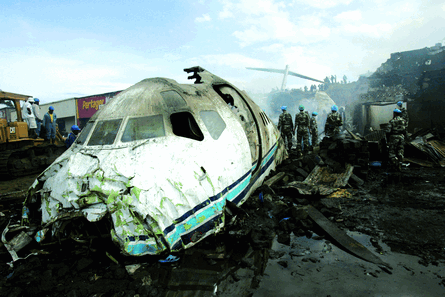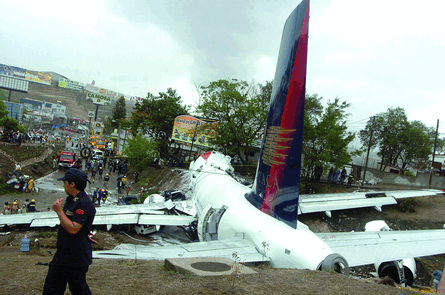These are short summaries of some final accident and incident reports published during the first six months of 2008. The events may have occurred in earlier years.
The final report into the 1 January 2007 crash of an Adam Air Boeing 737-400 in Indonesia says the aircraft plunged into the sea from cruise after the pilots became preoccupied with an inertial reference system malfunction and completely lost control. The report criticises the carrier, which has since had its licence to operate revoked, for failing to provide adequate training for the pilots.
 |
|---|
© Karel Prinsloo/AP |
Indonesia's National Transportation Safety Committee (NTSC) reports: "The cockpit voice recorder revealed that both pilots were concerned about navigation problems and subsequently became engrossed with troubleshooting inertial reference system anomalies for at least the last 13min of the flight, with minimal regard to other flight requirements."
While cruising at 35,000ft (10,670m) with the autopilot engaged, the captain noticed there was a significant difference between the aircraft's position as assessed by the two IRSs. The crew set the number two IRS mode selector to "attitude" and the autopilot disengaged, and the aircraft began a slow roll to the right. There were few attempts by the pilots to take corrective action even after a "bank angle" alert sounded when the aircraft's roll exceeded 35° right.
The NTSC says: "The flight data showed that roll rate was momentarily arrested several times, but there was only one significant attempt to arrest the roll. Positive and sustained roll attitude recovery was not achieved. Even after the aircraft had reached a bank angle of 100°, with the pitch attitude approaching 60° aircraft nose down, the pilot did not roll the aircraft's wings level before attempting pitch recovery in accordance with standard operating procedures."
The aircraft's pitch acceleration reached 3.5g with sustained nose-up elevator control input and speed rose to Mach 0.926. The recorded airspeed exceeded Vdive - 400kt (740km/h) - and reached a maximum of approximately 490kt just before impact. The aircraft suffered a "significant structural failure" because of the excessive speed, but by that time it was already in a "critically uncontrollable state", says the NTSC. The report notes more than 100 recently logged IRS-related failures for that airframe in the last three months of operation.
 |
|---|
The UK Air Accidents Investigation Branch has recommended that pilots be trained more rigorously to fly with sole reference to standby instruments following a serious incident on 22 October 2005 in which a British Airways Airbus A319 suffered an extensive loss of electrical power that deprived the pilots of all primary flight instruments at night. The AAIB has also advised BA to review its reporting procedures after the inquiry team learned about the incident only six days later, the jet having remained in service.
Despite the two-year investigation, the AAIB has been unable to determine the reason for the power loss, which affected the jet's left-hand electrical network, shortly after it took off from London Heathrow for Budapest on 22 October 2005. But it suspects one of the generator control units detected a false electrical current differential-protection condition. Failure of the network caused the loss of both pilots' primary flight and navigation displays, the upper electronic centralised aircraft monitor (ECAM) display, cockpit lighting, the radio and the intercom. The auto-thrust and autopilot also disconnected.
"This and other similar incidents show that there is at least one unforeseen failure mode on A320 family aircraft which can cause the simultaneous loss of the captain's and co-pilot's electronic flight instruments and the upper ECAM display," says the AAIB. Airbus has addressed AAIB concerns over power supply to standby instruments.
If the primary displays are unavailable, the A319 can be flown on standby instruments - including a horizon, altimeter, airspeed indicator and compass - but the AAIB report says: "The flightcrew had not received any formal training on how to operate A320-family aircraft by sole reference to the standby instruments." Most of the systems were recovered about 90s after the failure. The captain incorrectly believed that the fault lay in a transformer rectifier unit.
A Bombardier Challenger 604 crew's loss of control over the aircraft's horizontal stabiliser was caused by a fundamental design fault that allowed moisture ingress to affect both channels of the aircraft's pitch control system simultaneously, according to a report by the UK AAIB. A 604 crew, inbound to Farnborough, UK from Lagos, Nigeria, experienced intermittent loss of pitch trim, and eventually the reversal of direct manual trim commands leaving the stabiliser with heavy nose-down pitch. The crew committed to a flapless landing at Stansted because Farnborough's runway was not long enough, and they landed safely. The AAIB says that the manufacturer has taken measures to proof the horizontal stabiliser trim control unit against moisture ingress.
The US National Transportation Safety Board has reported that a Pinnacle Airlines Bombardier CRJ200 overran the runway at Cherry Capital airport, Michigan, on 12 April 2007 because the crew failed to revise their landing performance calculations, despite the fact that they knew they were landing in snowy conditions. No-one was hurt, but in the light of many recent overruns NTSB chairman Mark Rosenker said of the report: "Piloting an aircraft should not be guesswork. There are rules and procedures that need to be followed at all times, and it is imperative that the FAA enforce these recommendations." The report says the crew had been able legally to carry out an unreasonably long duty day, and that the FAA should address the affect of crew fatigue on decision-making capabilities.
For a full list of January - June 2008 accidents and incidents click here
Source: Flight International
















